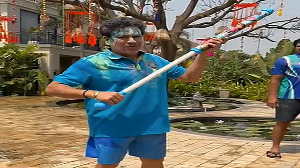The Bharatiya Janata Party seems to have bitten off more than it can chew on its own trademark issue: a Ram temple at Ayodhya.
On a question concerning the past, namely, whether a temple pre-dated the now-demolished Babri mosque, the BJP has failed to obtain a favourable archaeological or legal verdict. And on the future question, viz on finding a negotiated solution to the temple-mosque dispute, the BJP has been rebuffed by its own sister-organisation Vishwa Hindu Parishad, which accuses it of 'betraying' Hindus and 'selling out' simultaneously to Muslims and to the 'secular press!'
The temple issue, which catapulted the BJP into power and once united different Hindutva streams, now divides them sharply.
Of the BJP's two setbacks, the past one is undoubtedly the greater. Despite numerous extensions, archaeological excavation at Ayodhya has failed to turn up evidence that a Hindu temple existed at the site where the Babri mosque stood. The Archaeological Survey of India -- an agency under the ministry of tourism and culture, which reports to a government led by Hindutva zealots like L K Advani and Murli Manohar Joshi, themselves charged in the Babri demolition case -- has submitted two new 'status reports' to the Allahabad high court for the period, May 22 to June 19.
These too show no evidence of a pre-existing temple. If there was indeed a temple at the site, its structural remains would have been found beneath the Babri mosque's floor. But the only structures found from the pre-Babri period (that is, before 1528 AD) are brick or brick-bat walls and lime (chuna) and surkhi-plastered floors, characteristic of Islamic influence: in the early medieval period, India didn't have the technology to build brick-and-lime-mortar structures.
The ASI has dug extremely deep (up to 30 feet), that is, to early historic levels, and scoured the area with a fine toothcomb. But it has found nothing. Under pressure, and to 'play safe,' it asked for another fortnight's excavation, but that's highly unlikely to prove the claim that a temple was demolished at Ayodhya before the Babri mosque was built. [July 1, the ASI sought further time of three months to complete the work from the special Lucknow bench of the Allahabad high court].
According to leading medieval historian Irfan Habib and eminent archaeologist Suraj Bhan, 'matters have become definitively clear' with the ASI's latest reports based on 55 new trenches, which cover the entire mosque complex and much of the surrounding area, including sites right next to the 'makeshift' Ramlalla canopy.
The ASI has almost destroyed 'what the karsevaks had not demolished,' namely the mosque's floors and foundation walls. In good archaeological operations, 'such treatment of monumental remains would be deemed totally unprofessional and impermissible,' say these independent scholars.
The experts, and their associates Supriya Verma, Jaya Menon and Syed Ali Nadeem Rezavi --who closely observed the excavation as litigants' nominees -- conclude: 'In trench after trench, no structural remains below the mosque's floor level have been found at all. [Those] found in some trenches are all of construction associated with the [Babri] mosque.' Much fuss was made over the 'structural bases' or 'pillar bases' of a hypothetical temple, mentioned with 'some enthusiasm' in the ASI's first progress report. But these were found to be 'neither load-bearing nor in any way associated with any known tradition of Hindu temple architecture.'
Only seven were found in just six (of 100-plus) trenches. 'No alignment or uniformity of level is claimed for them.' They couldn't have been a temple's components. These experts say that a Devanagari inscription, about which a hullabaloo was made in Outlook magazine (June 2), was never projected on a screen, as claimed. It is a computer-manipulated image, which appears to be 'quite modern. [The letters] read napala du rabh, with no resemblance to the word swaahom followed by word Ram, as alleged.' The pervasive presence of animal bones with cut-marks and Muslim glazed ware, the discovery of finds with 'Arabic inscriptions of holy verses,' and the 'absence of even a trace of anything that could indicate structural remains of a temple,' suggest that the local pre-Babri habitation was ethnically mixed and had a strong Muslim component.
On the other hand, there is powerful evidence that underneath the Babri structure lay another mosque. 'The Babri Masjid structure was superimposed on a pre-existing mosque from the Sultanate period, which was constructed out of stones and plastered over with lime mortar, plastering being an art brought in by Muslims,' says Professor Suraj Bhan. (The Sultanate period refers to the three centuries-plus during which several Muslim kingdoms ruled northern India before the arrival of the Moghuls early in the 16th century.)
Also found under the Babri structure were graves. Underlying the Ram chabutra was a hauz (water reservoir) with a lime-plastered floor. Most of the other 'finds' or 'antiquities' were glazed pottery, pestles, bones, etc., which all point to the non-existence of a temple.
The excavation was not only extensive, but excessive: professional archaeologists would have dug just four or six trenches around the Babri structure, in place of the ASI's 100-plus. In archaeology, more isn't better. To prove that a temple existed, it's not good enough that divine statues or random Hindu objects are found. The sole proof is its structure -- plinth, base, walls, etc. This is absent. One must conclude that the VHP's temple claim is not based on facts. Nor is it backed by any scriptural authority or contemporary text. It's based on pure, invented, irrational faith.
In other words, millions of people were taken for a ride by Hindutva fanatics -- like medieval mobs who would hunt down witches on mere suspicion, or of illiterate peasants fooled by rumours that their water wells have been poisoned by 'hostile outsiders.' The entire Ayodhya movement was driven by invented faith, irrational revenge for 'past wrongs,' and false rumours.
This divisive, revanchist politics was designed to spread hatred, lynch people and create havoc.
Confronted with the new archaeological conclusion, the VHP, true to type, says it's a matter of faith, not truth. It demands that a grand temple must be built at the Babri site; a mosque can only be built 10 km away. But the Jama Masjid already exists, barely 1.5 km away, and there are other mosques close by too.
The VHP rejects even the formula suggested by the Kanchi Shankaracharya on the ground that he is a Shaivite (from the Shiva-worshipping tradition) whereas Rama belongs to the Vaishnavite tradition, being an avatar of Vishnu. The formula envisages building a temple and a mosque close to each other at Ayodhya, and dropping the VHP's claims on Mathura and Kashi.
The Shankaracharya is not a neutral party, but someone who is acting on behalf of the government, just as he did in March 2002 too. Yet, the VHP has rejected any give-and-take. It wants to impose its own will upon society: the temple must be built where we demand it -- the courts, archaeologists, historians, facts can go to hell. It's arrogating to itself the right to speak for 820 million Hindus and disenfranchise anyone who disagrees.
The VHP's imbecility has reached a point where its relations with the BJP have been badly damaged. Its working president Ashok Singhal isn't prepared to give up claims on Mathura and Kashi because 'Hindu samaj/' (read, VHP) will 'in no way' do so, although Parliament passed a law in 1991 freezing the status of all religious monuments (barring the Babri mosque) on August 15, 1947.
The VHP has no respect for the law of the land, leave alone tolerance or political decency. However, the VHP couldn't have become the monster it has without the BJP's active support, legitimation and collusion. It's a bit late in the day for Vajpayee to say, as he did on June 8, that the Ayodhya temple issue should be kept free of party politics. It is the BJP which politicised Ayodhya in the first place. Indeed, Mr Vajpayee himself declared the Ayodhya campaign a 'national movement.'
In truth, the various forces involved in the Babri mosque's politicisation and eventual demolition are indulging in finger-pointing, while deviously evading responsibility for that crime.
The time has come to adopt a clean, principled, transparent approach. This means accepting that no single organisation of the Hindus or Muslims, 'spiritual' or 'religious,' has the moral or practical authority to decide the fate of a highly sensitive issue like Ayodhya.
If no honourable, equitable compromise can be reached on Ayodhya, which wins the confidence of the Muslims, the courts must be left to deal with it. As of now, 85 percent of Muslims polled by Outlook-Cfore don't want to gift the Ayodhya land to the Hindus, without an assurance that the mosque will be rebuilt. Even if the Hindutva forces remain intransigent, an unfair settlement shouldn't be imposed on Muslims.
In situations where social negotiation breaks down, and political leaders cannot rise above petty differences, the law becomes the sole arbiter of disputes. Parliament legislation is no substitute for judicial determination. Whatever shape that determination takes, there must be no humiliating, dishonourable, unjust compromise which erases the heinous crime committed against the Indian people in December 1992.






 © 2025
© 2025